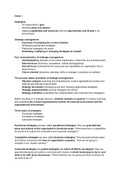Class 1
Strategies:
- An organisation’s goal
- Directing plans and actions
- Aligning capabilities and resources with the opportunities and threats in its
environment
Strategic management:
- A process of analyzing the current situation
- Developing appropriate strategies
- Putting the strategies into action
- Evaluating, modifying or changing strategies as needed
Four characteristics of strategic management:
- Interdisciplinary (focuses on the entire organisation, rather than any functional part)
- External focus (economy, competitors, market demographics)
- Internal focus (understands the resources and capabilities an organisation has or
doesn’t have)
- Future oriented (decisions, planning, shifts or changes in products or markets)
The process (basic activities) of strategic management:
- Situation analysis (scanning and evaluating the current organisational context and
external and internal environments)
- Strategy formulation (developing and then choosing appropriate strategies)
- Strategy implementation (putting strategies into action)
- Strategy evaluation (evaluating the implementation and outcomes from strategies)
Before deciding on a strategic decision, situation analysis is required. It involves scanning
and evaluating the current organisational context, the external environment and the
organisational environment.
Three types of strategies:
- Functional strategies
- Competitive strategies
- Corporate strategies
Functional strategies are also called operational strategies. They are goal-directed
plans and actions of the organisation’s functional areas. “What resources or capabilities
do we have to support the competitive and corporate strategies?”
Competitive strategies are also called business strategies. They are goal-oriented plans
and actions concerned with how an organisation competes. “How are we going to
compete in our chosen industry?”
Corporate strategies are guided strategies, by which all efforts are aligned. They are
goal-directed plans and actions concerned with choices of which businesses to be in, and
what to do with those businesses. “Which direction are we going and which business do
we want to be in?”
,Strategies are then implemented and evaluated (both their outcomes, and how they
were implemented).
The strategic management process is a continuous cycle. It is not sequential. It allows
for analysis of the current situation and enables adjustments to current strategies as needed
to pursue and achieve goals.
Although an organisation’s top managers have important strategic leadership
responsibilities, people of all levels play a role in development, implementation, evaluation
and changing of strategy.
Six key dimensions of leadership:
- Determining a purpose and vision of an organisation;
- Exploiting and maintaining core competencies;
- Developing human capital;
- Creating and sustaining a strong organisational culture;
- Emphasizing ethical decisions and practices;
- Establishing appropriate balanced controls.
, Class 2
Managing strategically is formulating and implementing strategies that allow
organisations to develop and maintain a strategic advantage.
Competitive advantage:
- Sets a company apart from others in the industry;
- Refers to what a company has or can do that others don’t have or can’t do;
- Possessing it means success and long-term survival;
- Is the purpose of strategic management;
- Requires understanding and capitalizing on the environment.
Industry and Organisational view / Input and Output view (I/O) focuses on structural
forces within an industry, the competitive environments of firms and how they influence
competitive advantage. It involves understanding what makes an industry attractive,
choosing an attractive industry to compete in, and choosing an appropriate
competitive position within that industry.
Resource based view (RBV) views organisational resources as essential to
competitiveness. Organisations are collections of assets and capabilities and uniqueness is
the basis for competitive advantage. The organisation needs to find a match between
resources and opportunities offered in the industry.
Organisational resources:
- Financial (cash, reserves, debt, equity, earnings);
- Physical (equipment, buildings, facilities, raw materials);
- Human (knowledge, skills, experience, competencies);
- Intangible (brand names, reputation, trademarks, patents);
- Structural/cultural (organisational history, culture, work systems, policies, trust,
relationships, formal organisational structure).
All organisations have resources. How they match to the environment and whether they
are unique will determine their effectiveness and whether they can contribute to competitive
advantage.




